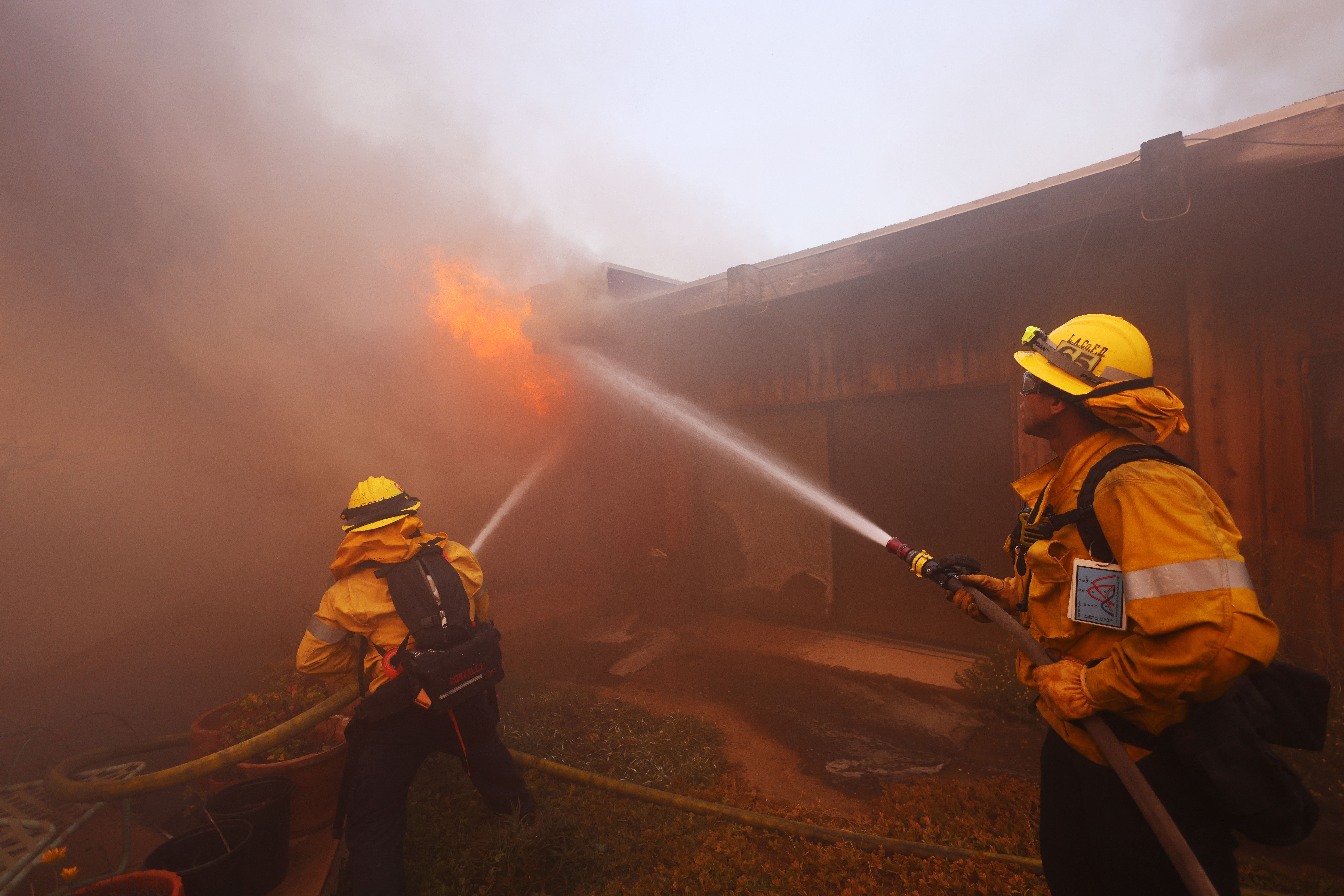Fires in LA Might Collapse California's Insurance Industry
The potential damages may exceed the capacity of the state's already overburdened insurer of last resort.

For years, the state's insurance market has been precariously close to insolvency due to catastrophic wildfires that have compelled many insurers to halt issuing new policies and to drop existing ones. The wind-driven fires on Wednesday in a Los Angeles neighborhood filled with multimillion-dollar homes could hasten its demise.
“It’s obviously going to be bad,” commented Rep. Brad Sherman, the Democrat representing the area between Malibu and Santa Monica, where the Palisades Fire—one of six uncontrolled blazes in the region—had already destroyed over 1,000 structures by Wednesday afternoon. “We’ve already seen big increases. And we’ve seen these increases not only in houses that are close to the brush, but in areas where you’re surrounded by other homes.”
President-elect Donald Trump addressed the situation on Wednesday, criticizing Democrats for the deadly wildfires fueled by strong winds that forced tens of thousands of residents to evacuate. “The fires in Los Angeles may go down, in dollar amount, as the worst in the History of our Country,” he posted on Truth Social. “In many circles, they’re doubting whether insurance companies will even have enough money to pay for this catastrophe.”
The FAIR Plan, California's insurer of last resort, expressed confidence in its ability to cover claims. “We are aware of misinformation being posted online regarding the FAIR Plan’s ability to pay claims,” stated spokesperson Hilary McLean. “It is too early to provide loss estimates as claims are just beginning to be submitted and processed,” she added, emphasizing that the plan is equipped for such disasters and utilizes payment mechanisms like reinsurance to manage claims.
However, California faces a dual threat: Private insurers may continue to revoke policies and refuse to underwrite new ones, following a trend that began with a series of severe fires starting in 2017 with the Tubbs Fire in Northern California. The FAIR Plan, which is already absorbing a dwindling private market, risks running out of funds to honor its claims.
If that occurs, it would not equate to bankruptcy, as McLean clarified. Instead, the FAIR Plan would seek to recoup costs from primary insurers under state law, resulting in increased premiums for all private policies and raising rates statewide.
“This is sort of what everybody's been preparing for,” remarked Karl Susman, an insurance broker in West Los Angeles who is assisting numerous clients with claims. “This is why rates are going up. This is why carriers are freaking out.”
State Farm reduced nearly 70 percent of its policies in the Pacific Palisades area last year—more than any other ZIP code in the state—believing it posed a significant risk. This shift directed more homeowners toward the FAIR Plan, initially established in the 1960s to insure neighborhoods in Los Angeles impacted by riots but now finding greater demand in rural and suburban regions prone to wildfires.
In Pacific Palisades, the FAIR Plan insures almost $6 billion worth of properties, according to figures from September—ranking among the top five communities statewide in terms of value. Overall, the total value of properties insured by the FAIR Plan across California amounts to $458 billion, which is three times greater than in 2020, based on data from the FAIR Plan.
The damages from the ongoing fires, currently estimated by AccuWeather to be between $52 billion and $57 billion, could escalate further as hurricane-force winds threaten thousands of additional homes.
"Should a large number of additional structures be burned in the coming days, it may become the worst wildfire in modern California history," stated AccuWeather chief meteorologist Jonathan Porter.
State officials, who have been attempting to mitigate the insurers' exodus, are preparing to limit the impact through measures such as a temporary year-long moratorium on non-renewals in areas affected by recent fires.
"Insurance companies are pledging their commitment to California, and we will hold them accountable for the promises they have made," Insurance Commissioner Ricardo Lara asserted.
Susman described the wildfires as a “proving ground” for recent regulations finalized by Lara to encourage property insurers to return to the market and increase their offerings in fire-prone areas.
These regulations allow insurance companies to pass the costs of reinsurance onto customers and use advanced “catastrophic models” that factor in the risk of climate-driven fires in Los Angeles while committing to a certain quota of policies in high-risk regions. Insurers like Allstate have indicated they will return to the market following these changes.
“If they hadn’t gone into effect in December, I could see the carriers literally saying, ‘Okay, we're leaving. We're done,’” Susman reflected on the new regulations. “Now, because they can properly underwrite, because they can offer certain types of discounts, and they can be more granular in how they're coming up with rates and underwriting, they can find a path back into the market.”
However, this outlook may be overly optimistic. Michael Wara, director of Stanford's Climate and Energy Policy program and a consultant to the state’s Public Utilities Commission on wildfire issues, warned that if insurance payouts continue to rise significantly, the new regulations might not suffice to retain insurers.
“We may have crossed a threshold now where we need larger measures in order to essentially create a solvent insurance system,” he cautioned. “And those measures are going to be politically difficult. They may create substantial risk for the balance sheet of the state of California.”
Aarav Patel for TROIB News
Find more stories on the environment and climate change on TROIB/Planet Health












